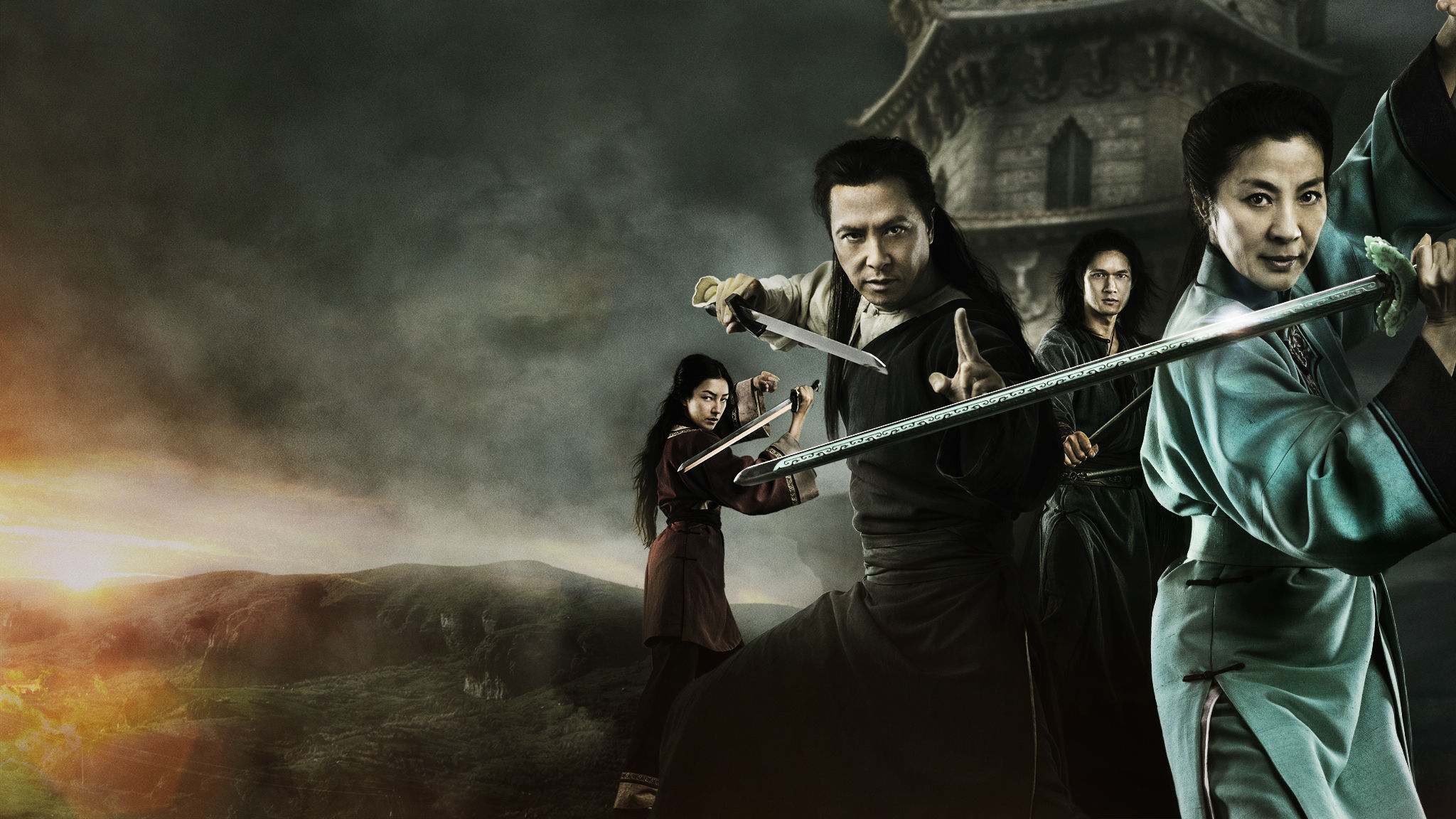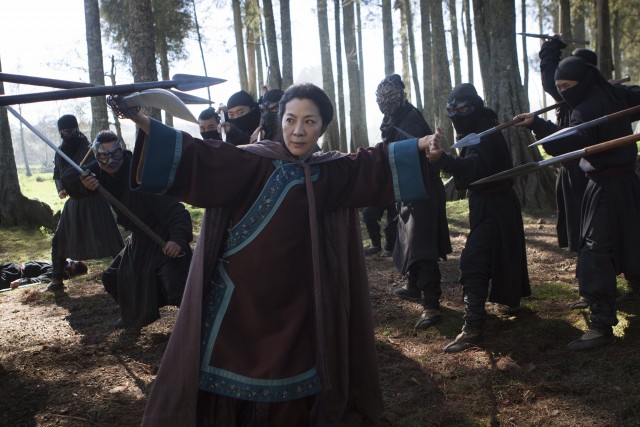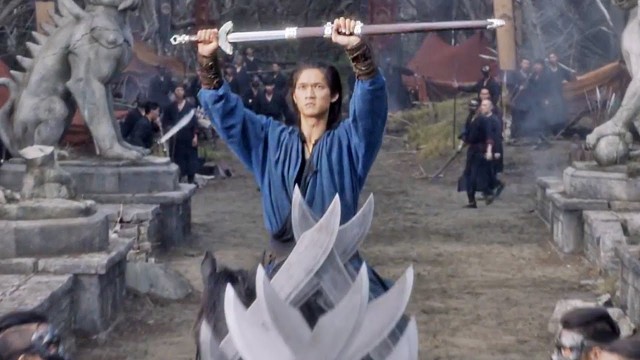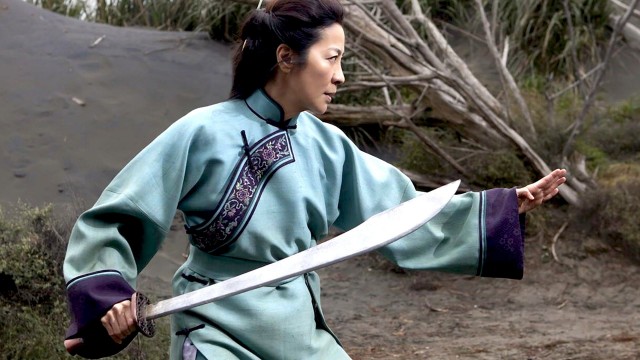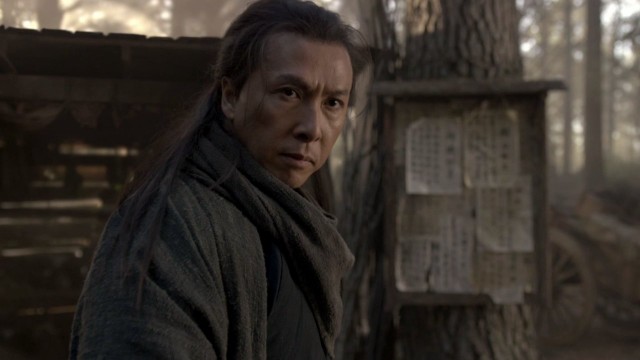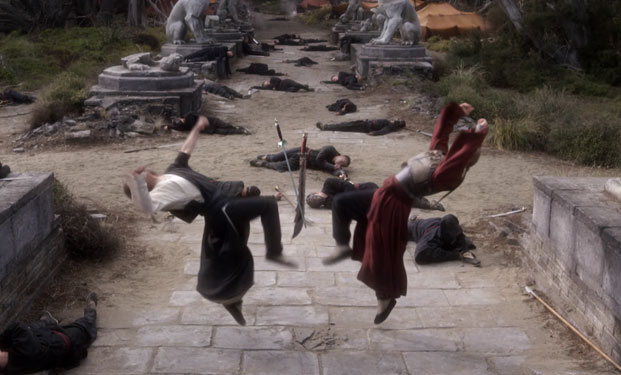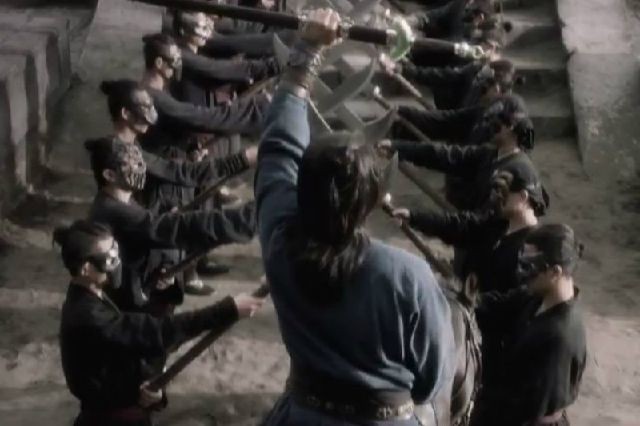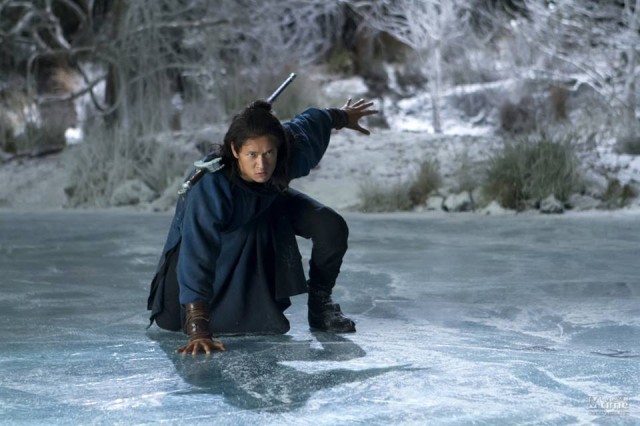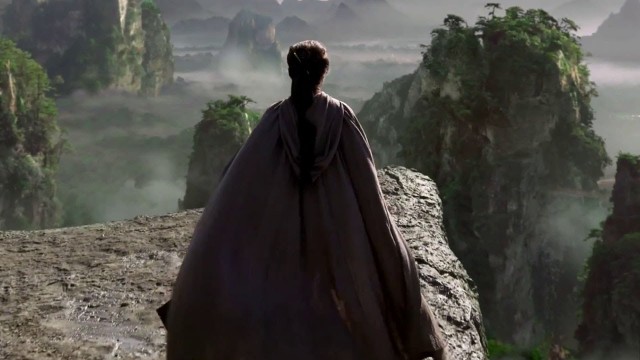Crouching Tiger, Hidden Dragon remains one of the most famous and beloved foreign-language movies of all time, even today. A huge surprise success in the Americas, the movie, directed by Ang Lee and adapted from the fourth novel within the pentalogy of Wuxia (martial arts-themed) novels called the Crane Iron Pentalogy, was nominated for and won several Academy Awards, and even secured a Best Picture nomination for the Oscars of 2000. The movie told a beautiful, poetic story amidst a backdrop of wonderfully choreographed, fantastical martial arts action, and ended on an effectively ambiguous note that nonetheless left the story fully resolved in a satisfying, memorable and powerful way.
So, it’s anyone’s guess as to why someone decided to make a sequel to such a masterpiece of a movie, an Oscar winner no less, that came out sixteen years ago. Regardless, here’s Crouching Tiger, Hidden Dragon: Sword of Destiny, supposedly loosely adapted from the fifth and final novel from the Crane Iron Pentalogy, which is actually known as Iron Knight, Silver Vase. Even more curious than the mere existence of this sequel however is the fact that it barely released in any English-speaking theatres at all, and even then, was only shown on about 15 IMAX screens here in the West, even if the movie did have a proper theatrical release in China. Instead, those of us in Western territories have to seek out Crouching Tiger, Hidden Dragon: Sword of Destiny on Netflix, where it’s the latest effort by the streaming service to expand its exclusive catalogue of feature films, following Beasts of No Nation and The Ridiculous 6.
So, given the enormous shoes to fill, does Crouching Tiger, Hidden Dragon: Sword of Destiny manage to live up to its lofty predecessor? No, no it does not. In fact, this movie, at worst, feels like a rather inexplicable cash-in that spawned from the name of another, better movie that came out over a decade-and-a-half ago, despite it being free to view for Netflix subscribers. In fairness, this sequel does still have some solid action in it, and does just enough to skirt by without feeling like a complete waste of time, but there’s no arguing that it comes off as a pale imitation of its inspiration, which was too high an achievement to be so easily replicated again.
One of the biggest problems with Crouching Tiger, Hidden Dragon: Sword of Destiny is that it barely seems to have any connection to its predecessor from 2000. There are only two real connecting threads to the first movie, with the first being the titular sword, the same Green Destiny blade that was wielded by Chow Yun-fat’s character in the first movie, and the second being the presence of Michelle Yeoh, reprising her role as skilled swordswoman, Yu Shu Lien.
To the credit of Sword of Destiny, it does attempt a plot twist with the new male lead of the movie, Meng Sizhao, a.k.a. Silent Wolf, who is played by martial arts star, Donnie Yen, which ties back into Yu Shu Lien’s backstory from the original movie. Even then though, the presence of Chow Yun-fat is hugely missed, with Yen’s attempt at quiet, tortured dignity not measuring up to the more appealing performance of Chow as Li Mu Bai in the original. Both Yeoh and Yen play their characters on the same note of understated pensiveness for pretty much the entire movie, only really amping up their emotions during the action scenes, and even then, they never really break from their seemingly endless introspection, which leads to slightly one-note performances.
Sword of Destiny also introduces a younger couple, in the form of Wei-Fang and Snow Vase, played by Harry Shum, Jr. and Natasha Liu Bordizzo, respectively, who basically feel like an attempt to play this sequel to a young adult audience. Shum, Jr. is at least one of the movie’s more interesting and fun characters, and Liu Bordizzo is acceptable as another transparent stand-in for a character from the first movie, in this case, Jen, who is also absent in the sequel, despite rumours that she would return. Perhaps it’s best that Jen isn’t featured though, since it means that this mostly unnecessary, lesser sequel avoids trampling on the poignant, ambiguous ending from the first movie.
With Jade Fox long dead, we also have a new villain in the sequel, Hades Dai, played by Jason Scott Lee. Dai wants the Green Destiny, for reasons, and that’s his entire character. He’s a flat villain that doesn’t even have that much screentime, and obviously doesn’t carry the same emotional weight that Jade Fox did in the first movie. He’s got some lieutenants that hang around, one of which is a bright-eyed lady that uses magic (yes, we now have bona fide magic in Sword of Destiny), but that’s about as distinct as they get. Dai and his lieutenants don’t do too much until the obligatory large-scale fight scene of the climax, with only one of them really making trouble for the leads in the interim.
The other personalities include some mercenaries that join up with Yu Shu Lien and her party to help fight against Dai’s forces, which are also more comical characters that are perhaps the biggest indication that this sequel has been extremely Westernized, compared to the more purist Chinese style of the original movie. Their sole purpose in the movie is to sit around, crack wise, and fight some people. They’re as stereotypical as mercenary characters get, and while they can be kind of fun in a couple of scenes, they don’t really add much to the movie, beyond a feeble attempt to expand the cast, and try to make the new cast a bit more distinct.
As you can see, there really isn’t much to say about the new personalities in Sword of Destiny. Even Yu Shu Lien feels dumbed down and less interesting in this follow-up, as she now struggles with a ridiculous conflict of hating violence, then just kind of not hating violence when it comes time for the climax. Even the twist with her character is brought up, and then largely resolves itself later, with barely any real development. It will make you long for the cast of the first movie, which was far more memorable, far more fleshed-out, and lent to far more compelling performances.
Similar to the personalities, the storyline in Sword of Destiny feels incredibly dumbed down compared to its predecessor. The whole premise of the movie involves Wu Shu Lien returning to the village from the first movie, safeguarding the Green Destiny even so many years later, and then a new villain wants the sword. So, Wu Shu Lien trains a new student, finds another guy that fits into it, and that’s about all. There is an honest effort made to give the story depth, but it just doesn’t work, and this sequel comes off as having a surprisingly bare-bones plot.
The real kick in the teeth for avid fans of the original movie however isn’t even that. It’s that Sword of Destiny was shot in English, and that’s its default language. Yes, really. One of the most famous foreign-language films of all time, spoken entirely in Mandarin, eventually produced a sequel that is shot and voiced entirely in English. There is an option for a Chinese dub, in fairness, but that’s just it; It’s a dub. It’s not the movie’s primary language. The fact that Sword of Destiny was shot in English is the biggest testament of all to it being an inferior, Americanized sequel, and needless to say, Crouching Tiger, Hidden Dragon deserves far better than that, if someone is going to undertake the enormous gamble of giving that movie a follow-up!
Whether you’re watching in English or subtitled Chinese however, the storyline of Sword of Destiny almost completely fails to engage. The effort to give characters interesting backstories and give the over-arching plot some weight is definitely there, but it just doesn’t come together, and it doesn’t effectively manage to hook viewers. The result is a sequel that feels thankless and unnecessary, and while it doesn’t tarnish the legacy of the original, it definitely doesn’t add anything to it.
Sword of Destiny is directed by Woo-Ping Yuen, who actually served as the action choreographer for the original Crouching Tiger, Hidden Dragon. From there, you can probably infer what this sequel’s main priority is.
To be fair, Woo-Ping has a pretty lengthy history of directing Asian cinema, though in recent years, he’s more or less abandoned that role in favour of stunt choreography. Sword of Destiny marks Woo-Ping’s first return to the director’s chair in quite a while, and it’s clear that he’s got some rust to work out. Woo-Ping directs the sequel competently, particularly most of the action scenes, though his character framing is definitely a lot weaker. Ang Lee added loads of rich depth to the cast of the original, but Woo-Ping doesn’t strive for the same level of depth. His direction definitely feels more laid-back and fun, but also less impactful.
Sadly, this is another thing that is holding back Sword of Destiny from even holding a candle to its esteemed predecessor. The way that the action scenes are shot is often great, though it’s a shame that the performances don’t measure up, and nor does the same sense of poetic style. Woo-Ping’s direction does carry a bit more weight than the downright graceful fights that Ang Lee helmed in the first movie back in 2000, but that doesn’t really translate to a better movie, since we’re not wanting for hard-hitting action flicks here in the West.
The music suite in Sword of Destiny is composed by Shigeru Umebayashi, a former Japanese rock star that later went on to score Asian films. His score in this sequel is adequate, and doesn’t particularly stand out, especially not compared to the more engrossing soundtrack that Tan Dun composed for the first movie. The sequel’s soundtrack yet again lacks the poetry that really defined the original movie, and in this case, it feels like a typical Hollywood score, with barely any sort of harmony with the movie’s ancient Chinese backdrop.
As for the rest of the sound design, it’s pretty solid for a movie that’s primarily made for Netflix. Like I said, it carries more weight than the gentler and elegant sound design from the original movie, and still manages to sound good enough, even without the advantage of a theatre screen for those of us outside of China. The action in particular now feels more harrowing and powerful, to the point where this sequel feels all the more loosely connected to its predecessor. It’s good on its own merits, though again, compared to the first movie, it stands out a lot less.
Another element to Sword of Destiny that’s a bit tricky to evaluate is its visual choreography. Whereas Crouching Tiger, Hidden Dragon was put together with lots of old-fashioned wire work and related martial arts stunts, Sword of Destiny is a lot more CGI-heavy, pretty much to a fault. Even as a follow-up to a movie where most of the characters were graceful to the point of pretty much flying around all over the place, Sword of Destiny feels floaty, and like it’s largely taking place in a fantasy world, rather than a fantastical world that feels semi-believable, like with the first movie. This ironically creates a reduced sense of danger that deflates the action to a point, despite the increased punch behind most of the fight scenes.
Fortunately, Sword of Destiny at least shines in terms of its action choreography, which is re-tooled compared to the more methodical, graceful style of the first movie, but is still objectively very impressive. Most of the movie’s action scenes are pretty decent and stylish, with a highlight including a fight on a frozen lake that almost does feel like it could have measured up to some of the martial arts sequences from the original movie. Despite the lack of creative restriction that Netflix allows versus the ratings boards that regulate theatrical movie content in various regions, the movie still pretty much unfolds in a PG-13 style as well, without much in the way of graphic violence. In fact, some of the action choreography even feels like it’s intentionally played for cartoon-style silliness, which fans of the stark serious original probably won’t like, but those who are coming into the sequel fresh may find these bits semi-amusing, if they remove the first movie from the equation.
Crouching Tiger, Hidden Dragon: Sword of Destiny joins the theatrical release of Zoolander 2 as a 2016 movie sequel that arrives around a decade-and-a-half after its predecessor, is far too late to the party, and all in all, should not exist. If you really love the original movie, then you’ll probably be sadly let down by this largely superfluous follow-up, which predictably fails to measure up to its predecessor in any meaningful way, and is sadly another sub-par offering for Netflix’s rather shaky Original Film selection to date, even if it’s definitely leagues better than the infuriatingly abysmal The Ridiculous 6.
There are bright spots to Sword of Destiny, sure, and as a disposable action flick, it’s not bad. The action choreography is pretty stylish, the glossy visual palette, while not true to the original once again, is pretty appealing to look at, and there are a handful of amusing moments that will merit a good chuckle or two. Sword of Destiny has almost nothing to do with its predecessor though, and were it not for Michelle Yeoh, you probably wouldn’t have put together that it’s supposed to be a sequel to Crouching Tiger, Hidden Dragon.
Since Crouching Tiger, Hidden Dragon is also available to watch on Netflix in its entirety, you’re probably better off just re-watching that if you’re feeling nostalgic, and want something that measures up to the lofty standard of that experience. The sequel works as something that curious fans can check out once, and then immediately forget about, especially if they have any actual expectations from it. The follow-up avoids being a truly bad movie, but it is very forgettable, and doesn’t manage to justify its existence. You’ll get some decent ass-kicking out of the deal, but Netflix is already full of other movies that even offer that in greater quality.

